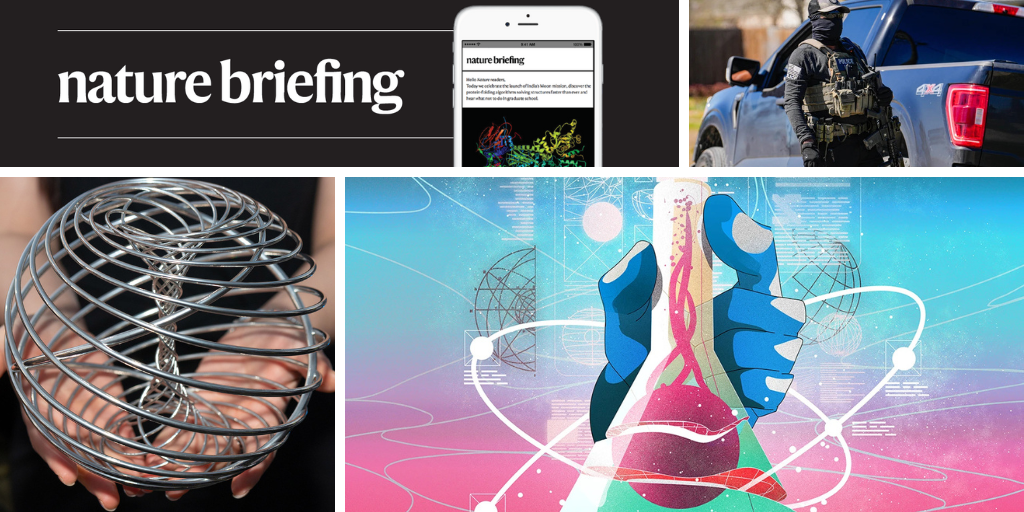You have full access to this article via your institution.
Hello Nature readers, would you like to get this Briefing in your inbox free every day? Sign up here.

The Breakthrough prize trophy’s design is inspired by imagery from science, including black holes, seashells and the structure of DNA.Credit: The Breakthrough Prizes
Five scientists who contributed to the development of the blockbuster weight-loss drugs Ozempic and Wegovy have picked up one of this year’s Breakthrough prizes — the most lucrative awards in science. The prize is shared between the four researchers who discovered and characterized GLP-1, and Lotte Bjerre Knudsen of the pharmaceutical company Novo Nordisk, who spearheaded the development of drugs based on these discoveries. One of the fundamental-physics prizes was awarded to 13,508 physicists for work done at CERN, Europe’s particle physics laboratory. The prize money will be used to fund international students to visit the collider. Other Breakthrough prizes were given to scientists for their research into multiple sclerosis, for creating the gene-editing technologies known as base editing and prime editing, and for proving a mathematical concept called the geometric Langlands conjecture.
The critically endangered sunflower star has found a refuge to protect itself from a mysterious disease in Canadian coastal fjords. Pycnopodia helianthoides reaches one metre in diameter and has as many as 24 arms. But it disintegrates in a few days when exposed to sea star wasting disease, whose cause is unknown. Since 2013, the disease has killed 90% of sunflower stars worldwide. Researchers found that, in the deep, cold fjords of British Columbia, populations remained stable, showing signs of disease but without high mortality.
Reference: Proceedings of the Royal Society B: Biological Sciences paper
Features & opinion
Andrew Robinson’s pick of the top five science books to read this week includes a look at an outbreak of overdiagnosis, a natural history of the neck and a thought-provoking right-wing perspective on the problems with academia.
The growing role of artificial intelligence (AI) in science could do more harm than good if modelling-based approaches are wielded without nuance or understanding, argue computer scientists Arvind Narayanan and Sayash Kapoor. “Errors are becoming increasingly common, especially when off-the-shelf tools are used by researchers who have limited expertise in computer science,” they write. And, even if it’s error-free, “it is easy for researchers to overestimate the predictive capabilities of an AI model, thereby creating the illusion of progress while stalling real advancements”.
Before he was a hitting co-ordinator for the New York Yankees, Aaron Leanhardt was a physicist. When the team wanted to find a way for some of its players to boost their hitting power, he put his skills to work: the result is the ‘torpedo’ bat, which moves the centre of mass closer to the hands. Whether the bat has really given hitters an advantage, or it’s just the placebo effect, the result has been a “home-run barrage”, writes sports reporter Louisa Thomas.
On Friday, our penguin-seeking puzzle brought us to the stunning moss-covered banks of Coal Creek in the Coeur d’ Alene National Forest in Idaho. Did you find Leif Penguinson? When you’re ready, here’s the answer.
Thanks for reading,
Flora Graham, senior editor, Nature Briefing
Want more? Sign up to our other free Nature Briefing newsletters:
• Nature Briefing: Careers — insights, advice and award-winning journalism to help you optimize your working life
• Nature Briefing: Microbiology — the most abundant living entities on our planet — microorganisms — and the role they play in health, the environment and food systems
• Nature Briefing: Anthropocene — climate change, biodiversity, sustainability and geoengineering
• Nature Briefing: AI & Robotics — 100% written by humans, of course
• Nature Briefing: Cancer — a weekly newsletter written with cancer researchers in mind
• Nature Briefing: Translational Research — covers biotechnology, drug discovery and pharma


